- In the Ecuadoran Amazon, a boom in legal and illegal gold mining has sparked Indigenous land rights conflicts and water contamination in the Anzu and Jatunyacu rivers.
- Recently analyzed water samples from the region reveal high concentrations of toxic metals, such as lead and aluminum, that are up to 500% higher than permissible limits.
- In some of the sites studied, aquatic insects had disappeared, indicating high levels of pollution and serious health impacts to communities relying on the rivers for water and fish.
- Recent court hearings have ordered mining companies to offer reparations to affected communities and undertake clear consultation processes.
In Ecuador’s central Napo province, legal and illegal gold mining in rivers is expanding, causing freshwater contamination and conflict among communities living in the Anzu and Jatunyacu river basins, according to recent studies and Indigenous organizations. The findings, signaling a gold rush in the Amazonian province, identify several new mining concessions and their environmental impacts between December 2019 and January 2022.
These concessions were granted without consideration of existing mining projects in the area, resulting in concerns about Indigenous rights violations and water contamination through toxic waste. This has been further exacerbated by a lack of regulation, management and effective control by the Ecuadoran government, according to a study in the journal Land. By 2020, 152 concessions were recorded in the national mining registry, or cadastre, in Napo province, according to another study, this one published in the journal Toxics.
The most recent concessions were granted to TerraEarth Resources SA, consisting of 7,125 hectares (17,606 acres) divided into four projects in an area made up of eroded alluvial terraces that descend toward the Anzu River.
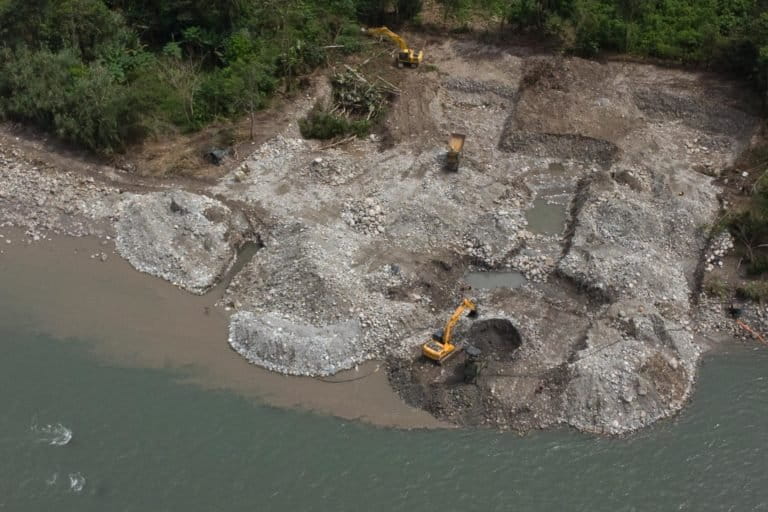
Napo has abundant mineral reserves that are relatively easy to access. But this isn’t the sole reason a gold rush has struck the region. The complicity of large landowners and environmental authorities plays a big part, says Carlos Mestanza-Ramón, lead author of the Land study and a researcher at the University of Calabria, Italy, and Polytechnic School of Chimborazo, Ecuador.
Mestanza-Ramón says Ecuador’s Ministry of Environment, Water and Ecological Transition doesn’t carry out the necessary enforcement, which further emboldens mining activities, often illegal.
“[They] know that evading the control system is relatively easy in an industry where power and money can carry great weight,” Mestanza-Ramón says.
After 30 to 35 backhoes were found operating illegally 24 hours a day near the Anzu River, Mestanza-Ramón conducted an interview with the owner of the machines. He estimates that, thanks to the heavy machinery, the operators were extracting 54 kilograms (119 pounds) of gold per day, with profits of $1.5 million dollars every day.
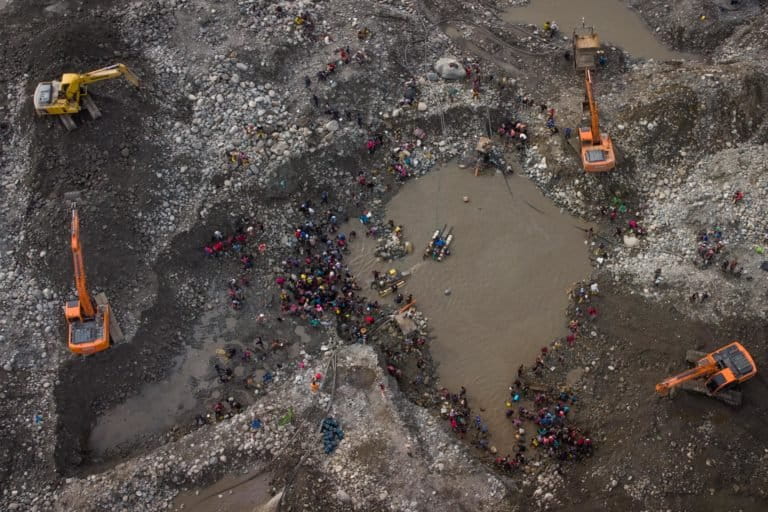
Extracting gold from riverbeds, a process known as alluvial mining, often involves the use of mercury to bind the flakes of gold. The process is notorious for causing mercury pollution, and one of the most visible impacts that surveyors found in Napo was the dumping of toxic byproducts and residual rocky materials into the Anzu and Jatunyacu rivers. This has clouded the water and suppressed the aquatic life at some of the sampled sites.
At least 1,500 Indigenous communities in the Napo province are affected by gold mining, particularly through land degradation, loss of livelihood and health problems. Most concessions are located the cantons of Carlos Julio Arosemena Tola (which has 32 registered mining concessions) and Tena, which has 85.
Contaminated rivers affect aquatic life and food
Recent water samples from the upper basin of the Napo River, near the Jatunyacu River, collected by researchers at IKIAM Amazon Regional University in Napo, found that 73% of the monitored water bodies were of poor quality. Many rivers were severely degraded. They also discovered high concentrations of toxic metals such as lead and aluminum in the water, up to 500% above the permissible limits in Ecuador.
“Before I started to crawl, I swam in this river,” Majo Andrade, a member of the Indigenous Kichwa community of Serena located in Tena, tells Mongabay in a video interview. In 2011, she says, she first noticed “big machines and cars” appear in a spot near her home on a beach in the Jatunyacu Basin.

The machines stripped the riverbank of its forest cover to expand access roads for more machinery and to create pools for the mining waste, known as tailings. The large amounts of earth from digging these pools were piled up into heaps, which later eroded due to intensive rainfall in the area.
“At the time it broke my heart. I saw where we used to play and it was gone, everything was gone and the river was contaminated,” Andrade says.
Researchers assessed the environmental impacts of gold mining contamination at 11 different sites in Napo province. They focused on water quality levels, concentrations of metal exposure, insect communities, and toxicity levels. Their analysis revealed, across all sites studied, that dissolved oxygen levels were below permitted levels and were slightly lower than those reported in a previous monitoring study. This indicates an increase in mining activity and a worsening of the water quality.
“In some rivers, we did not find the presence of any macroinvertebrates, which clearly tells us that the rivers sampled are completely polluted,” Rodrigo Eduardo Espinosa, a researcher from the IKIAM Amazon Regional College, tells Mongabay. “Even [the organisms] that can tolerate pollution to a certain extent cannot survive in these conditions.”
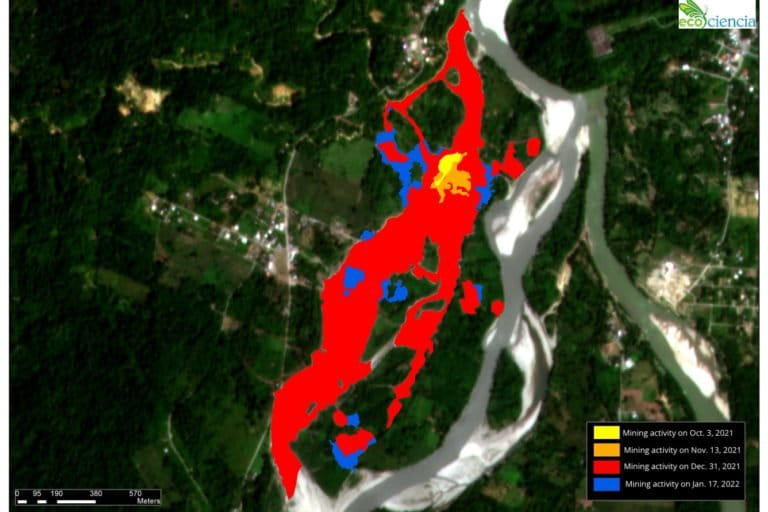
The sedimentation and contamination from gold mining have direct negative effects on the communities that depend on these water sources. The pollution reduces the abundance and richness of mayflies, beetles and water bugs that occur here, the researchers say. The prolonged absence of these macroinvertebrates indicates an elevated degree of environmental disturbance and serves as a “warning indicator” for pervasive mining effects.
“Among the diseases that mining can cause are skin diseases, various types of lung diseases due to the inhalation of certain gases that are released, and several types of cancer,” Espinosa says.
Mariana Capparelli, another researcher from the IKIAM Amazon Regional College who was also involved in the study, tells Mongabay that the degree of contamination in the observed sites makes it hazardous to consume the water or the fish.
“It could be that local communities have been consuming water and fish with metal levels above the recommended for a relatively long period already,” she says.
These impacts are something Leo Cerda, another member of the Serena Kichwa community living near the Jatunyacu River, has experienced firsthand.

“As a child, I used to go to the river to play with my friends and drink from the water every day,” he tells Mongabay in a video call.
Back then, he says, the rivers ran clear, except during the rainy season when they would turn a slightly darker tone due to the heavier rainfall. But as the years passed, Cerda noticed the water growing increasingly murky, even outside the rainy season. The water was contaminated, and the effects were felt almost immediately in the community.
“There was a lot of stomach issues, a lot of sicknesses,” Cerda says. “My town was this tiny piece of paradise in the middle of the Ecuadoran Amazon. We had no mining, we had no oil, and now, since the government began granting concessions, violence and crime have increased.”
Ecuador’s Ministry of Environment, Water and Ecological Transition and the Ministry of Energy and Nonrenewable Natural Resources did not respond to Mongabay’s requests for comment.
An illegal mining boom
About 60% of mining concessions in this region are authorized for artisanal mining, which is also practiced by Indigenous and local communities. But industrial gold mining accounts for 98% of the total territory designated for gold mining in Napo province.
Due to low corporate taxes and special income taxes that were implemented in 2015 and 2016 by Rafael Correa, Ecuador’s then-president, to encourage foreign investment by mining companies, an influx of new concessions has since followed.
A report by the Critical Geography Collective, an organization which brings together geographers, social scientists and environmental activists to research territorial tensions in Ecuador, the largest concessions are held by TerraEarth Resources SA. The company did not respond to Mongabay’s requests for comment.

Illegal mining has also expanded in several parts of the Amazon Basin. Some companies with concessions that no longer meet legal requirements continue mining illegally, despite being suspended by the state. Seventy-seven percent of Ecuador’s gold production was extracted illegally in 2016, and this number continues to increase, researchers say.
In November 2021, the Agency for the Regulation and Control of Energy and Non-Renewable Natural Resources (ARCERNNR) carried out a raid on illegal mining in Napo’s southwest Yutzupino region, one of the territories that make up the El Icho mining concession. Authorities arrested four people on charges of illegal mining.
Despite this recent raid, Cerda says enforcement action against illegal mining is rare. When inspections are planned, mining companies are often alerted beforehand, giving them time to remove their machinery and avoid having them confiscated.
“One of the biggest problems affecting the province right now is illegal mining,” said Wilfrido Villagomez, the governor of Napo, at a press conference in December. “Many factors disable control operators from getting the expected results, such as the presumed leakage of information, a lack of technical and logistical equipment, a lack of resources, and the entailment of communities in operations of illegal exploitation.”

According to Cerda, illegal mining has also increased due to lack of opportunities for residents: decent employment, basic education, and health care in Indigenous and local communities. It’s the neglect by the Ecuadoran state that has allowed illegal activities to proliferate, Cerda says.
“Mining is gaining attention from a lot of people because they can gain money quickly,” Andrade says.
Pepe Moreno, a member of the Indigenous organization Napo Ama La Vida, this has generated conflicts within and between communities. For some, the arrival of companies to the canton of Carlos Julio Arosemena Tola since the 2000s has brought jobs. For others, the impacts of mining on agriculture, tourism and the environment have cost them their jobs.
According to Mestanza-Ramón, it’s this split over mining that’s become the main source of division in the society.
The most recent census, from 2010, put the population of Carlos Julio Arosemena Tola at almost 15,000 inhabitants, of whom nearly half identified as Indigenous. Despite more than 10 years of mining activity in the canton since then, 80% of the population still lives below the poverty line.
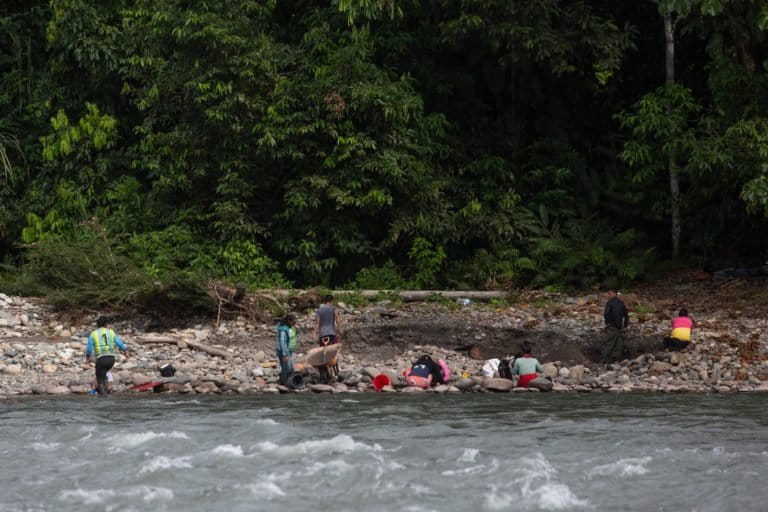
Andrés Tapia, from the Confederation of Indigenous Nationalities of the Ecuadoran Amazon (CONFENIAE), tells Mongabay the situation is critical due to a “lack of control by the authorities and the environmental ministry.”
A favorable court ruling
In October 2021, the Federation of Indigenous Organizations of Napo (FOIN), together with various parish and social groups and individual communities, filed a lawsuit against the Ecuadoran state for violating their rights to free, prior and informed consent (FPIC) when approving mining projects in the province. The Tena Alluvial Project, they argued, is one such case.
Indigenous groups throughout the Amazon have often denounced the approval of mining concessions without their consultation. Some mining companies carry out a false process of citizen participation, by obtaining informal agreements with residents, or by currying favor through the distribution of food or other items, researchers say.
“We started this to stop mining companies drilling in our territories,” Cerda says. “Especially our rivers. They are creating divisions in our communities, they are dividing families, exacerbating the social structure, increasing violence, and contaminating our territory.”
A lack of agreement presents a challenge when it comes to regulating the sector, manifested in the constant struggle between Indigenous groups and representatives of transnational corporations and government authorities.
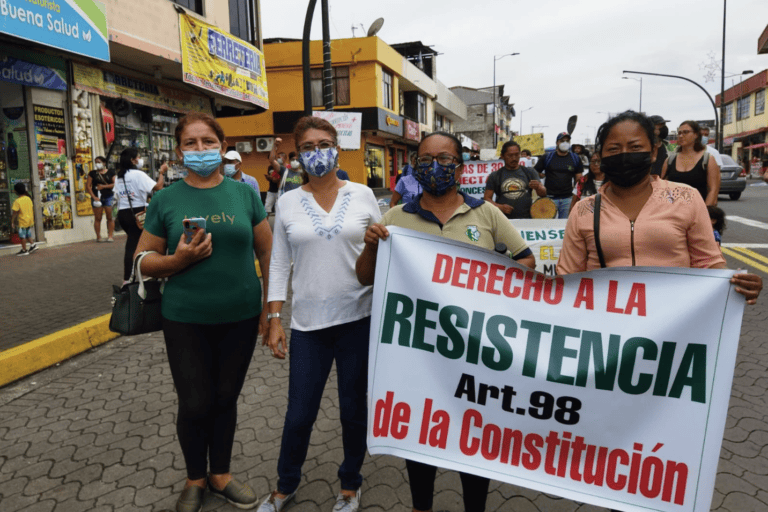
On Jan. 17 this year, Constitutional Court Justice Roberto David Saravia Altamirano partially accepted FOIN’s demands, recognizing violations in regards to the rights of nature. The court issued reparation measures to combat the impact of alluvial mining in the area.
Another recent victory in the fight for the protection of Indigenous peoples’ rights may set a precedent for courts to also consider the rights of Indigenous communities in similar cases. On Feb. 4, a landmark ruling by the Constitutional Court of Ecuador was announced, calling for stronger protections to guarantee Indigenous communities’ rights to decide over extractive projects in their territories.
For communities in Napo province, this presents a potential milestone for conflicts with mining companies operating on Indigenous land. According to Lina Maria Espinosa, a senior attorney with Amazon Frontlines, the ruling will have an immediate impact on any oil or mining activity in any Indigenous territory in the country, as they must now undergo a consultation process with communities and obtain the community’s consent.
Citations:
Mestanza-Ramón, C., Cuenca-Cumbicus, J., D’Orio, G., Flores-Toala, J., Segovia-Cáceres, S., Bonilla-Bonilla, A., & Straface, S. (2022). Gold mining in the Amazon region of Ecuador: History and a review of its socio-environmental impacts. Land, 11(2), 221. doi:10.3390/land11020221
Capparelli, M. V., Cabrera, M., Rico, A., Lucas-Solis, O., Alvear-S, D., Vasco, S., … Moulatlet, G. M. (2021). An integrative approach to assess the environmental impacts of gold mining contamination in the Amazon. Toxics, 9(7), 149. doi:10.3390/toxics9070149
Galarza, E., Cabrera, M., Espinosa, R., Espitia, E., Moulatlet, G. M., & Capparelli, M. V. (2021). Assessing the quality of Amazon aquatic ecosystems with multiple lines of evidence: The case of the Northeast andean foothills of Ecuador. Bulletin of Environmental Contamination and Toxicology, 107(1), 52-61. doi:10.1007/s00128-020-03089-0
Villacís S, Ochoa J, Borja MO, Josse C, Finer M, Mamani N (2022). Illegal Mining in the Ecuadorian Amazon. MAAP: #151.
https://maaproject.org/2022/mining-ecuador/
Banner image: Large machines to process gold in the Jatunyacu River. February 11, 2022. Image courtesy of Iván Castaneira.
Related reading from Mongabay Latam: Ecuador: la minería ilegal está acabando con dos ríos de la provincia de Napo
Related listening from Mongabay’s podcast: A conversation with Cultural Survival’s Daisee Francour and The Oakland Institute’s Anuradha Mittal on the importance of securing Indigenous land rights within the context of a global push for land privatization. Listen here:
FEEDBACK: Use this form to send a message to the author of this post. If you want to post a public comment, you can do that at the bottom of the page.
